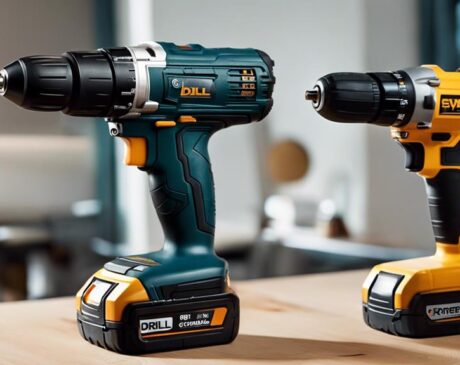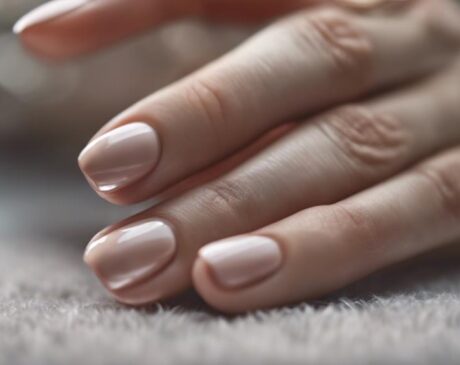Why Do Fake Glue on Nails Hurt?
If your fake glue-on nails hurt, it could be due to improper application techniques or using the wrong nail size. Make sure your natural nails are clean and dry before applying. Press down firmly for a secure attachment. Avoid excessive glue to prevent discomfort. Consider if the nails are the correct size to prevent pain and nail damage. Moisturize and nourish natural nails for support. Use proper techniques when removing and filing nails. Remember, proper maintenance is essential. More helpful tips await to improve your fake nail experience.
Key Takeaways
- Incorrect sizing causes discomfort and pain.
- Excessive pressure leads to potential damage.
- Allergic reactions to glue result in irritation.
- Weak, poorly cared for natural nails lead to discomfort.
- Improper application techniques weaken the bond, causing pain.
Improper Application Techniques
When applying glue-on nails, ensure they're correctly positioned and securely attached to prevent discomfort and damage to your natural nails. To start, make sure your natural nails are clean and dry before applying the glue-on nails.
Position the fake nail just above the cuticle, avoiding contact with the skin. Press down firmly for a few seconds to secure it in place. Avoid using too much glue, as this can cause the nail to lift and create discomfort.
Once all nails are applied, gently file them to your desired shape, but be careful not to file too aggressively, as this can weaken the bond. Remember, proper application techniques are crucial for a comfortable and lasting wear.
Incorrect Nail Size
When your glue-on nails are the wrong size, they can cause discomfort and pain.
Your nails may press against your natural nails, creating painful pressure points.
This can lead to improper attachment, making your nails more likely to fall off prematurely.
Wrong Nail Fit
Choosing the correct size of glue-on nails is crucial to avoid discomfort and potential damage to your natural nails. When the nails are too small, they can dig into your nail beds, causing pain and irritation. Conversely, if the nails are too large, they can put pressure on the sides of your natural nails, leading to discomfort.
To ensure a proper fit, make sure the fake nails cover your entire nail bed without extending over the edges. Remember, wearing the wrong size of glue-on nails can't only be uncomfortable but also increase the risk of your natural nails getting damaged. So, take the time to find the right fit for a pain-free and enjoyable experience.
Painful Pressure Points
To prevent painful pressure points when wearing glue-on nails, ensure they fit properly to avoid discomfort and potential damage to your natural nails. Incorrectly sized nails can create painful pressure points that dig into your nail beds, causing soreness and even bruising.
When nails are too large, they can press against your skin, leading to irritation and pain. On the other hand, nails that are too small might cause your natural nails to bend or lift, resulting in discomfort.
Improper Nail Attachment
Improperly sized glue-on nails can lead to discomfort and potential damage to your natural nails. When you choose fake nails that are too large or too small, they can press against your nail bed, causing pain and even soreness.
Nails that are too big may catch on things, increasing the risk of them getting lifted or torn off, which can be painful. On the other hand, nails that are too small mightn't cover your natural nails completely, leading to uneven pressure distribution and potential bending or breaking.
To avoid these issues, always make sure to select the right size of glue-on nails that fit your natural nail shape and size snugly for a comfortable and secure attachment.
Allergic Reactions to Glue
Experiencing allergic reactions to glue when using fake glue-on nails can cause discomfort and irritation, potentially leading to more serious skin issues if not addressed promptly. Allergic reactions to the adhesive used for fake nails can manifest as redness, itchiness, swelling, or a rash around the nail area. These reactions occur when your body's immune system identifies certain ingredients in the glue as harmful, triggering a response.
If you notice any of these symptoms, it's crucial to remove the fake nails immediately and wash your hands thoroughly. Applying a soothing cream or taking an antihistamine can help alleviate the discomfort. To prevent allergic reactions in the future, consider using hypoallergenic nail adhesives or consulting a dermatologist for allergy testing.
Excessive Nail Pressure
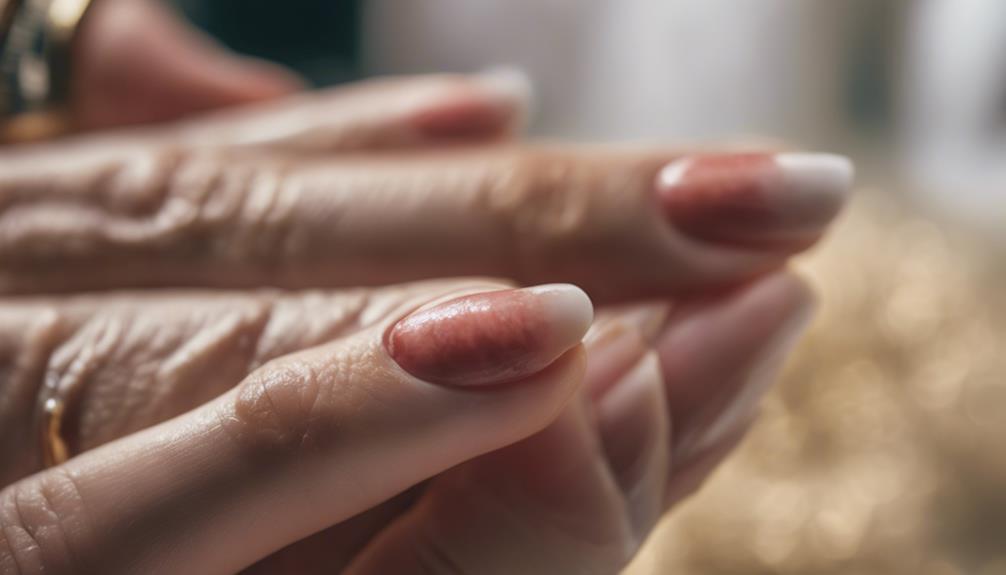
Excessive nail pressure from tightly applied fake glue-on nails can lead to discomfort and potential damage to your natural nails. When you opt for a snug fit or apply too much pressure while attaching fake nails, you might be setting yourself up for some serious nail issues. Your natural nails are delicate, and excessive pressure can cause pain and soreness.
If you feel any discomfort, it's essential to address it promptly to prevent further damage. Your nails need room to breathe and move naturally; tight glue-on nails can restrict this movement, leading to discomfort. Remember, your nails aren't meant to withstand constant pressure, so it's crucial to strike a balance between a secure fit and allowing your nails some freedom.
If you experience any pain or notice changes in your natural nails, it might be time to give your nails a break and let them recover. Prioritize the health of your nails to avoid long-term damage caused by excessive pressure from fake glue-on nails.
Trapping Bacteria Underneath
Trapped bacteria underneath fake glue-on nails can lead to potential infections if not properly addressed. When bacteria get stuck under your fake nails, it can cause irritation and even more serious issues if left unchecked. Here's how to prevent this from happening:
- Cleanliness is Key: Make sure to thoroughly clean your nails before applying fake glue-on nails. This helps reduce the chances of trapping harmful bacteria underneath.
- Proper Maintenance: Regularly clean underneath your fake nails to prevent the buildup of dirt and bacteria. This simple step can go a long way in keeping your nails healthy.
- Choose Quality Products: Opt for reputable brands and quality products when applying fake nails. Cheaper alternatives may not adhere as well, leaving space for bacteria to thrive.
Nail Bed Damage
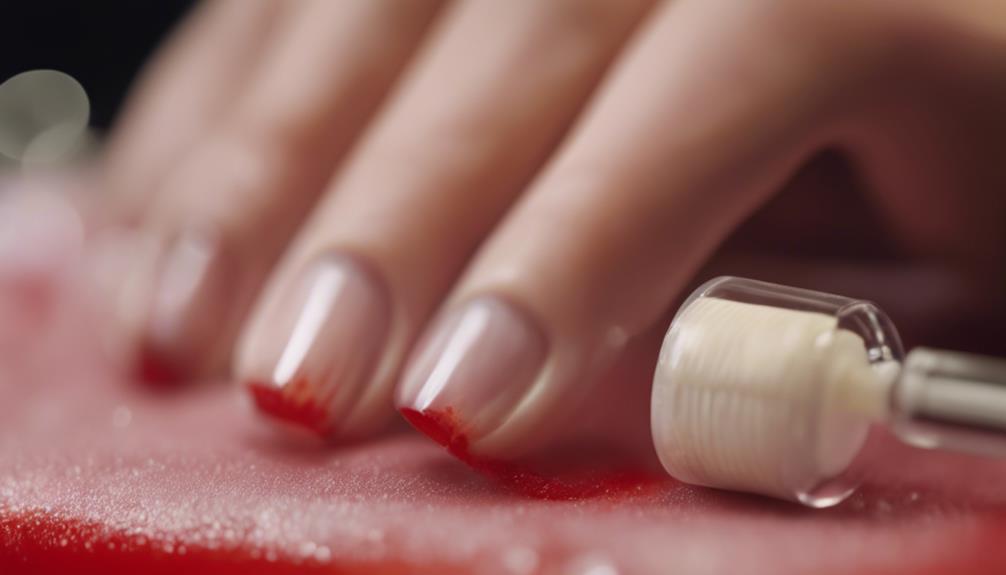
To prevent nail bed damage while wearing fake glue-on nails, regularly moisturize and nourish your natural nails to maintain their health and strength. When your nail beds lack moisture, they become brittle and prone to damage. Dryness can lead to cracking, peeling, and weakening of the nail structure, making them more susceptible to injury when wearing fake nails. By keeping your natural nails hydrated and healthy, you provide a strong foundation for the glue-on nails to adhere to, reducing the risk of nail bed damage.
Additionally, be gentle when applying and removing fake nails to avoid unnecessary trauma to the nail bed. Rough handling can cause the nail to lift or tear, leading to pain and potential damage. If you notice any signs of nail bed damage such as redness, swelling, or tenderness, remove the fake nails immediately and allow your nails to recover before applying them again. Prioritizing the health of your natural nails is essential in preventing nail bed damage and ensuring a comfortable experience when wearing fake glue-on nails.
Poor Nail Quality
Maintaining proper nail care is crucial, as poor nail quality can significantly impact the durability and comfort of fake glue-on nails. If your natural nails aren't in good shape, it can lead to discomfort and potential damage when using fake glue-on nails. Here are some key reasons why poor nail quality can cause issues with fake nails:
- Weakness: Weak, brittle nails can struggle to support the weight and pressure of fake glue-on nails, leading to breakage and discomfort.
- Uneven Surface: Nails that are uneven or ridged can cause the fake nails to not adhere properly, resulting in a less secure fit.
- Moisture Imbalance: Nails that are overly dry or excessively moist can impact the adhesive of the fake nails, causing them to lift or not stick properly.
Taking care of your natural nails by keeping them strong, smooth, and at the right moisture level can help ensure a more comfortable and long-lasting experience with fake glue-on nails.
Inadequate Nail Removal
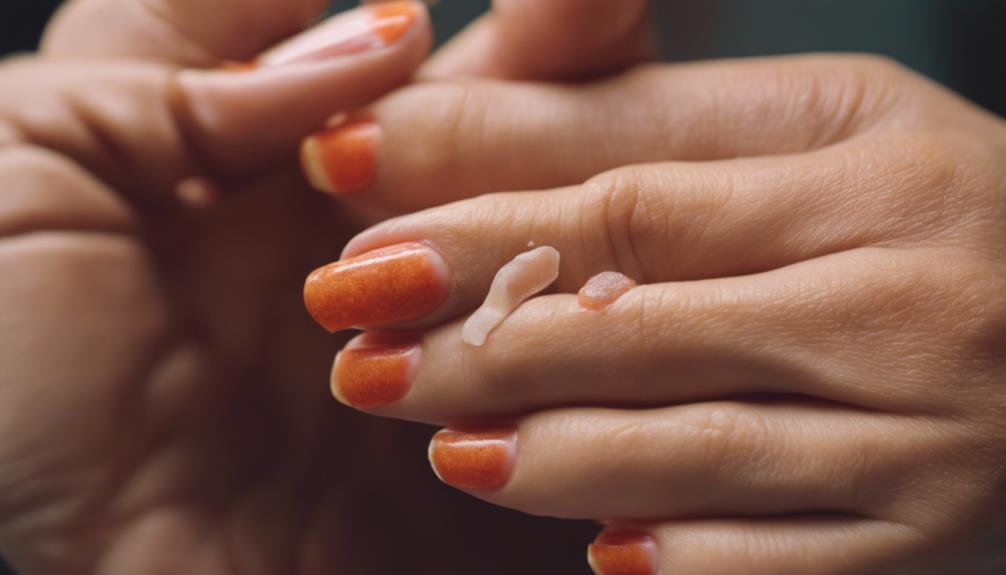
When removing fake glue-on nails, ensure thorough and proper removal to prevent potential damage to your natural nails. Rushing through this process can lead to nail trauma and weaken your nail beds. Here are some key points to remember for safe and effective nail removal:
| Tip | Description | Benefit |
|---|---|---|
| Use acetone | Soak a cotton ball in acetone and place it on your nail for proper dissolution | Helps soften the glue for easier removal |
| Gently file nails | Lightly file the surface of the fake nail to break the seal without damage | Prevents excessive force on natural nails |
| Moisturize | Apply cuticle oil or moisturizer after removal to hydrate and nourish nails | Promotes healthy nail growth and strength |
Taking care during nail removal is crucial for maintaining the health and strength of your natural nails. By following these steps, you can enjoy the freedom to experiment with different nail styles without risking damage to your nails.
Nail Filing Mistakes
When filing your nails, avoid the common mistake of sawing back and forth, as this can weaken the nails.
Make sure to file in one direction to prevent splitting and peeling.
Also, be cautious not to over-file, as this can lead to thin and weak nails.
Improper Nail Filing
Improper nail filing techniques can lead to damage and discomfort when applying fake glue-on nails. To ensure a pain-free experience and maintain healthy nails, follow these essential tips:
- Avoid over-filing: Refrain from filing your nails too aggressively, as this can weaken them and make them more prone to breakage.
- File in one direction: Opt for a gentle back-and-forth motion in one direction instead of a sawing motion, which can cause splintering and rough edges.
- Use a fine-grit file: Choose a fine-grit nail file to prevent excessive friction and damage to the nail bed, promoting a smooth finish without compromising nail health.
Incorrect Nail Shape
Filing your nails into incorrect shapes can lead to discomfort and potential damage when applying fake glue-on nails. When you file your nails, it's crucial to follow the natural curve of your nail bed. Avoid sharp angles or overly rounded shapes that don't match your nail's natural contours.
Incorrectly shaped nails can create pressure points when you attach fake nails, causing pain and even potential nail damage. To prevent this, gently file your nails into a shape that mirrors your cuticles and follows the natural line of your fingertips.
Lack of Nail Maintenance
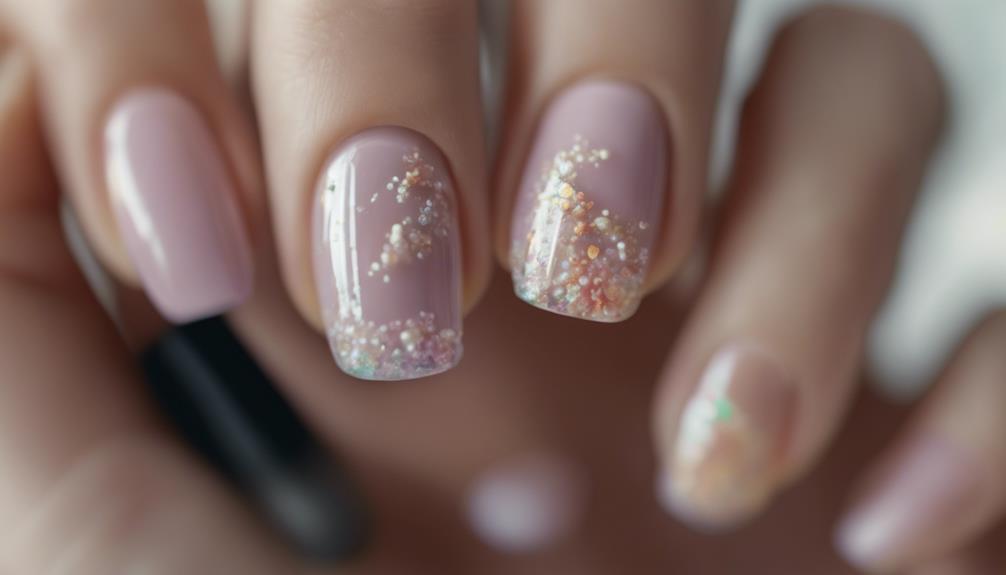
Neglecting regular care for your natural nails can lead to discomfort when using fake glue-on nails. When you don't maintain your nails properly, it can cause issues that make wearing fake nails painful and unpleasant. Here's why:
- Brittleness: Failing to keep your natural nails moisturized and trimmed can lead to brittleness. This makes them more prone to breakage and can cause additional stress when wearing fake nails.
- Uneven Surfaces: Lack of maintenance may result in uneven nail surfaces. When you apply glue-on nails over rough or uneven natural nails, it can create pressure points that lead to discomfort.
- Weakness: Without proper care, your nails can become weak and prone to bending. Weak nails struggle to support the fake nails, causing pain and potential damage.
To ensure a comfortable experience with fake glue-on nails, prioritize regular nail maintenance. Keep your nails healthy, moisturized, and properly shaped to prevent discomfort and enjoy your artificial nails to the fullest.
Frequently Asked Questions
Can Fake Glue on Nails Cause Long-Term Damage to My Natural Nails?
Sure thing! Fake glue on nails can potentially cause long-term damage to your natural nails if not applied or removed carefully. It's crucial to follow proper procedures to maintain nail health and avoid any potential issues.
Are There Any Alternative Methods to Fake Glue on Nails That Are Less Painful?
Looking for less painful alternatives to fake glue on nails? Try press-on nails or nail wraps. They provide a stylish look without the discomfort. Remember to follow proper application and removal techniques for the best results.
How Can I Prevent Fake Glue on Nails From Lifting or Falling off Prematurely?
To prevent fake glue on nails from lifting or falling off early, ensure proper application by cleaning nails, using quality glue, and pressing firmly. Also, avoid excessive water exposure and use a top coat for extra durability.
Can Fake Glue on Nails Lead to Infections or Other Health Issues?
Fake glue on nails can introduce bacteria if not applied properly, potentially leading to infections. Ensure cleanliness before application, monitor for signs of irritation, and remove promptly if discomfort arises to prevent health issues.
Is It Safe to Continuously Wear Fake Glue on Nails Without Giving My Natural Nails a Break?
Wearing fake glue on nails continuously without breaks can weaken your natural nails, making them brittle and prone to damage. It's important to give your nails a breather to prevent long-term harm.

